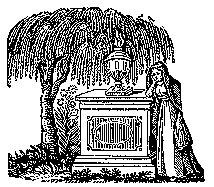
Gothic Gardening: Theme Gardens
Growing your Grave Goods
Unlike the modern aphorism, 'You can't take it with you', most cultures
around the world did a great deal to make the transition into the
Afterworld comfortable for the being in question, which meant including
objects in the grave which would travel with the person. These objects
were often of a person nature, and would include stones, artifacts, minerals,
shells, vessels, amulets, food, and drugs. The Neanderthals of Shanidar
put flowers in graves 60,000 years ago. To help you with the selection
of plant material that you would like included in your gravesite with
you, here are plants that have traditionally been included in graves from
cultures all around the world. Many of these plants have interesting
properties, which makes them valuable while you're still alive, too.

- Beans
- Beans of some sort were part of belief systems just
about everywhere in the world. They were considered guardians of life
energy and food of the gods. Many beans have 'magical effects', and as
such, had cults surrounding them, such as the mezcal bean. Other beans
were used as death charms, such as jequirity, which was ground and
then brushed across the threshold of a house. The person entering
barefoot would then die. Bean fetish objects were often included in
graves.
- Cedar
- This was used by the Egyptians for magical cosmetics and
perfumes, incense, and to embalm mummies. It was also venerated by the
Romans and the ancient Mesopotamians. In his Herbal, Dioscorides
called cedar "the life of death".
- Colorines
- The Aztecs associated colorines with sacrificial death. They
carved figures of their gods from the wood, and used the beans as an
aphrodisiac and for producing dreams.
- Ephedra
- One of the oldest magical plants known to man, ephedra was used
in the Iranian Haoma cult, Tantric moon rituals, orgiastic Saturnalia, and
N.A. Indian vision quests. Consequently, the leaves of this plant were
often included in the funerary goods.
- Guayusa
- This type of holly grows in Ecuador, and has been
found in graves there dating from 500 BC. The leaves were found in
medicine bags, along with snuff pipes. This plant is supposed to give
strength and auspicious dreams, and is used as an emetic and enema.
- Hemp
- While I would never suggest that anyone grow this (oh no,
never. really.) hemp is one of oldest cultivated plants. It was
originally grown in China, and has been used by almost every culture
in Asia, Africa, and Europe. It's medicinal and inebriant uses are
well known.
- Lotus
- The lotus flower is a symbol of perfection, immortality, and
enlightenment. The roots and seeds were used as amulets.
- Maize
- The Maya say that maize has the greatest life energy of
any plant. Dried kernels are used as oracles and worn as
amulets. Maize supposedly has the power to dispel demons.
- Maté
- Maté Yerba shrub leaves were found in
pre-Columbian graves in the Andes. The leaves were placed in gourds
lined with silver, so the dead could make maté tea and remain awake
on their journey to the afterlife.
- Poppy
- This was one of the plants, along with henbane,
thornapple, and tobacco, which later became associated with
witches. However, poppy capsules have been found in archaeological
sites in Switzerland which belong to the Lake Dwellers, and are 4000
years old.
- Prickly Poppy
- Aztecs thought that 'all poisonous plants are
eaten in the underworld, and all who go there eat prickly poppy'. This
is a medicinal plant with many uses.
- San Pedro Cactus
- A Peruvian plant, also found in pre-Columbian
graves, which was used for traveling to unseen worlds.
- Tobacco
- Originally a New World plant, it was adopted into
magical ceremonies all over the world. Mayan temples and pyramids are
decorated with images of the plant and their gods smoking tobacco. It
was an important inclusion in pre-Columbian graves.
- Boxwood
- Now used mainly as a hedge, sprigs of boxwood were found in three early
Roman coffins (probably a local custom). Much later, the English used boxwood at funerals.
The custom was to leave sprays of it next to the door so that people could take a spray
and throw in into the grave at the appropriate time.
- Juniper
- The coffin juniper, Juniperus recurva var. coxii, has
a resinous wood that is used for Buddhist incense and for, obviously, making coffins.
The Greeks burned juniper berries at funerals to repel demons.
Main Index
Gothic Gardening is copyright (c) 1995-1997
by Alice Day (mAlice).
All Rights Reserved.
--unless otherwise attributed--


